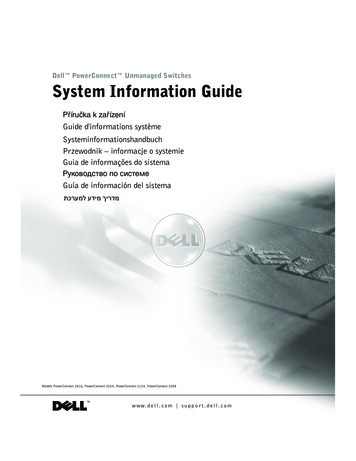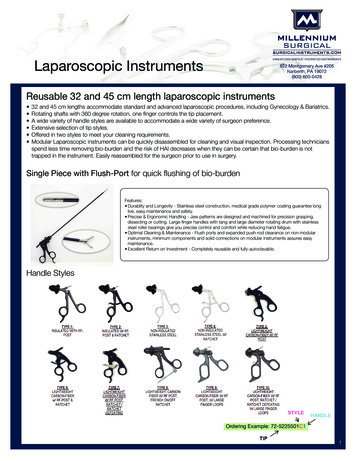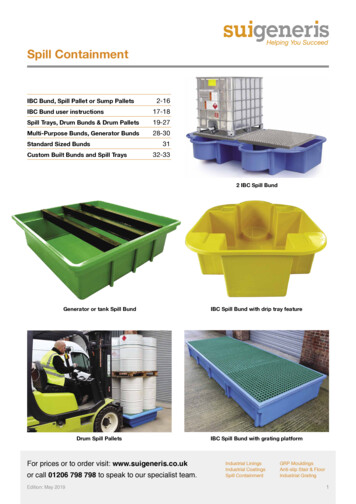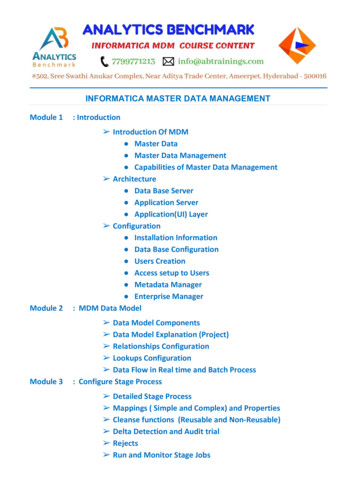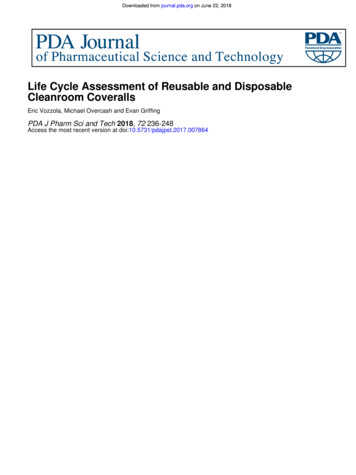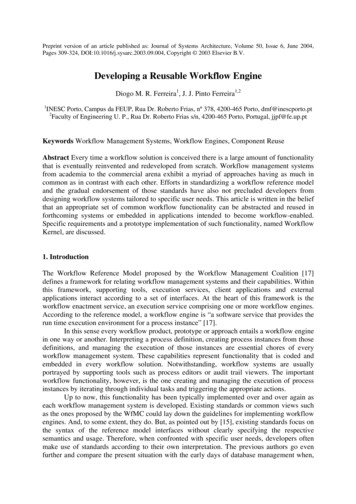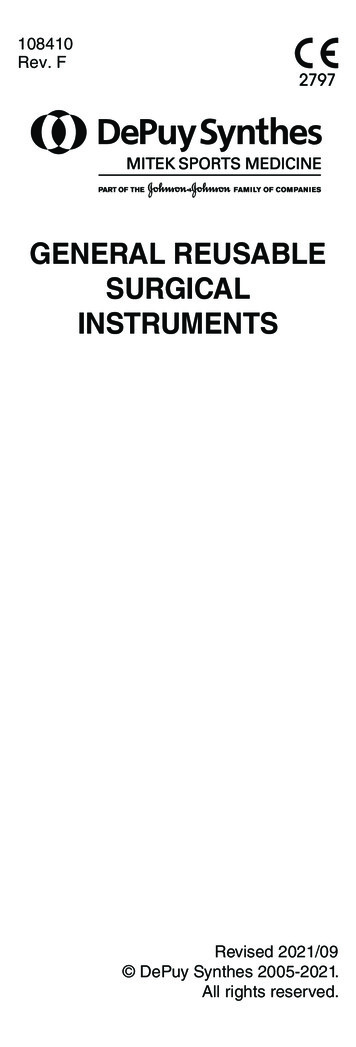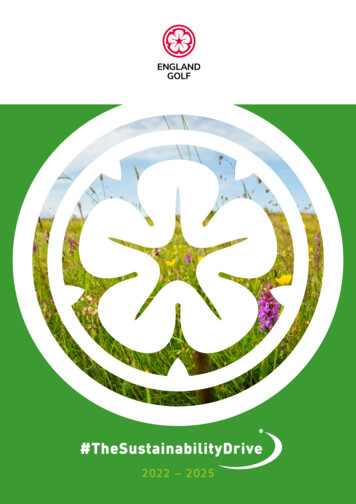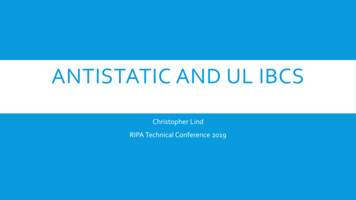
Transcription
ANTISTATIC AND UL IBCSChristopher LindRIPA Technical Conference 2019
AGENDA Background EX Antistatic/Static Dissipative IBCs UL or FM Certified and NFPA Compliant IBC Reprocessing and Reuse
RIPA TECHNICAL CONFERENCE: 2019- Schuetz has proposed a new international standard to establish tests todetermine the electrostatic properties of composite IBCs- Company is concerned that because composite IBCs are used for thetransportation of increasing amounts of flammable (ignitable) liquids, testsare needed to ensure safety- New tests would apply to both new and reconditioned composite IBCs.
RIPA TECHNICAL CONFERENCE: 2019- Proposal has been submitted to the International Electronics Commission (IEC)- Includes new definitions for-ReconditioningRebottlingPeriodic retestingConductively encased IBCsRIBCs
INTERNATIONAL REGULATIONS—USE ANDSTORAGE IEC, International Electrotechnical Commission produces standards These standards are aimed at protecting workers and property from electricalhazards IEC has grouped explosion hazards into levels from 0 to 2 with 0 being the worst Flammable liquids in IBCs must be in units that protect from electrostaticdischarge in explosion Zones 1 and 2. CENELEC is the EU specific standards organization to which the IBC must betested
DOMESTIC REGULATIONS—USE ANDSTORAGE In the US NFPA establishes requirements for IBCs used for flammable liquids.NFPA Flammable Material is not permitted in a composite IBC in insideunprotected storage. NFPA Combustible must be in the UL 2368 or FM 6020compliant. Anything over a 37.8C flash point NFPA II, IIIA, and IIIB from SDS NFPA 30 more stringent more testing maybe more UL IBCs UL 2368 Used to be w IBC filled w WaterThen filled with NFPA IIIB Mineral Seal OilNow, in order to be used with NFPA II or IIIA it must be tested w those chemicals.No history of problems with either UL IBC. NFPA writes Codes. The state or local jurisdiction must make it a law.
TRANSPORT REGULATIONS UN Regulation: any flammable liquid with a flash point 60C (or a dust liable toexplode) must be electrostatic discharge protected Not in 49 CFR except for fuel filling in the field—IBC from pickup to use.49 CFR mandates static protection when dischargingUN 60C is any Class 3 PHII or PGIII liquidIf the shipper is fully compliant the IBCs received into the reco stream from EU withClass 3 flammable, PGII or PGIII may have an EX layer UN Writes Model Regulations. It is up to each country to accept it verbatim intotheir laws or modify. US Modifies Canada, Mexico, less modification to comply w US joint agreements EU very close to UN
WHAT LADINGS ARE MORE LIKELY TO BE IN EX OR UL? Static Accumulators-Yes PaintsSiliconesHydrocarbonsAlcoholsFlavors & FragrancesPetrochemicalsFuelsSolventsAny Class 3, PGII or PGIIINFPA II, IIIA, IIIB4/25/2019 Static Non-Accumulators - No AcidsSalt solutionsAlkalisAqueous materialsGrounding and Bonding IBCs and Drums
SOURCES OF STATIC – SPECIFIC TO PLASTIC DRUMSAND IBCS Flowing liquid through pipes, hoses and valves Filling drums or IBC-splashing fill is the worst People—people hold more static than an IBC or drum and can discharge to the container –10100 millijoules versus a plastic bucket at 10% of that value Agitation-mixing in the drum or IBC Wiping down equipment or tops of IBC or drum. Blot don’t rub ! Static free wipes are best. Induction—a charged object put closed to non-charged object Dry air4/25/2019Grounding and Bonding IBCs and Drums
STATIC PROVIDES IGNITION ENERGY
STATIC PROVIDES IGNITION ENERGY
WHAT MAKES AN EX IBC? Typically an EX IBC will be a multilayer IBC 2, 3, 5, 6 layers. Single layer IBC would be too expensive to make the bottle 100% EX An additive to the outer layer of polyethylene, (PE), dissipates the static charge thataccumulates This additive does not impair the recycle and reuse of the plastic The pallet must either be steel, have conductive plastic components, or a grounding strap fromcage to ground The conductive plastic pallet merely has a special carbon black—no effect on reuse There are wood pallet approved EX units with grounding straps completing the circuit to ground The valve must be grounded to the cage or pallet
COEXTRUSION (3 LAYERS)3-layer technology 3 LayersAdditional outer layer– New HDPE layer– PE regrind– Outer HDPE layer additionalUV-Protection for fillinggood, conductive oranti-static, etc.Cenelec EX certification
ANTISTATIC IBC Multilayer inner receptacle, whichincorporates an external layer ofpermanent antistatic plastics compound. Conductive pallet. Ground strap/rod on valve. Grounding wire/strip from lading to steelcage or pallet. Approved for use in explosives Zones 1and 2. Not flame resistant. Meets UN model regulations. Not UL
UL IBCS– EX PROTECTION AND UL 2368 COMPLIANCE EX Compliant IBC UL 2368 tested and compliance for fire resistance 20 minutes conflagration with 2 L/min heptane fire.Double stack can’t tip 6 degreesNo leakageReduces potential for pool fires spreading to other containersUL 2368 compliance required in 36 states and many regional districts4/25/2019SM 13 EX IBC15
UL IBC FIRE TEST
EVOLUTION OF UL IBC—POSSIBLE OLDERUNITS AROUND
EVOLUTION OF UL IBC—THE OLD TCSHOULD BE ALL GONE
SPECIFIC CONSIDERATIONS FORPROCESSING AND REUSE EX1.These likely had solvents and flammable materials—check that the plastic hasnot softened2.In older units, the Antistat layer may be abraded off, or if left in harshsunlight—get pressure washed off3.The CENELEC certification does not prohibit reuse—HOWEVER1.2.3.4.4.If sold as an EX you must be able to verify it is still static dissipativeIt must be sold with a conductive pallet—no switchingThe valve must be a grounded valve—no switchingNeed Yellow sticker w warningsThe potential liability is very high on these. It may be best to use as a “regular”IBC or even non-UN.
SPECIFIC CONSIDERATIONS FOR PROCESSINGAND REUSE EX—IEC WORK ITEM There is a work item proposed to standardize and codify the testing andinspection procedures for EX IBCs Require verification by authorize procedure that the IBC – used or new – is indeed staticdissipative to the limits specified Require verification the valve is earthed Require the valve has a positive connection between the liquid and groundingwire/strap/rod Require verification the pallet and all components are earthed Require 30 month inspection May require every reuse inspection Require yellow sticker on plate and TE Cap Must verify conductance “meterologically” .i.e. surface ohmmeter More work and more expense for a Reconditioner
SPECIFIC CONSIDERATIONS FORPROCESSING AND REUSE UL IBC1.These likely had solvents and flammable materials—check that the plastic hasnot softened2.The unit, once opened/used, is no longer NFPA compliant. It can’t be sold asUL. Very high potential liability to resell as UL/FM.3.Bottle and cage may be acceptable as UN or non-UN unit.4.You may be able to return clean parts to the OEM for their disposition5.If the bottle and valve were antistat, it would be best to avoid guaranteeing thereco unit is still antistat.6.UL Sticker has to come off the cage/plate. Just the UL, not UN string andstacking marks if processed and sold as UN.
RIPA TECHNICAL CONFERENCE: 2019- ICCR has asked to participate in a joint ISO/IEC standards workgroup for theproposed standard.- ICCR is concerned about:- Definitions (must comport with existing national and international regs)- Possible excessive testing requirements- Limitations on reuse (proposed standard would require the use of an “authorizedappropriate” replacement inner receptacle- Excessive recordkeeping requirements
THANK YOU FOR YOUR ATTENTIONQUESTIONS?
Filling drums or IBC-splashing fill is the worst People—people hold more static than an IBC or drum and can discharge to the container -10-100 millijoules versus a plastic bucket at 10% of that value Agitation-mixing in the drum or IBC Wiping down equipment or tops of IBC or drum. Blot don't rub ! Static free wipes are best.
